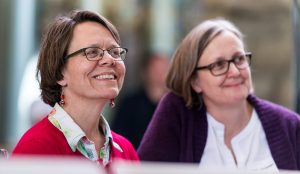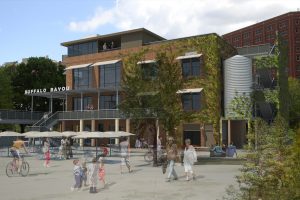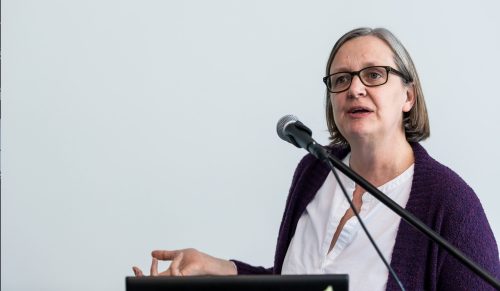
Part 3 | Women in Design: Pillars of BNIM’s Legacy – Sarah Hirsch
This March, in celebration of Women’s History Month and 50 years as a practice, we are reflecting on legacy here at BNIM. The journey of our practice – the projects, discoveries, movements, and milestones — is a journey shaped by the passionate, dedicated team of professionals and practitioners who have helped build, guide, and inspire the firm. Among these impactful BNIMers is a group of individuals who, together, represent a long history of pioneering change at BNIM and in the industry. As true innovators, advocates of sustainable practice and policy, and leaders of our firm, BNIM’s women in design are pillars of the firm’s legacy.
We had the opportunity to sit down with several of our female leaders at BNIM who have each shaped the firm through their respective practice and leadership over the last three decades. From Maria’s pioneering work in business development and communication in the AEC industry, to Barb leading the way for females in the architectural practice, to Sarah advancing the continually evolving area of sustainability within architectural specifications, to Laura advocating for global sustainability and resilience from the beginning of the movement in the 1990s — our interviewees have long been at the forefront of innovation in practice, and each continues to shape new paths forward. We are excited to share a series of interviews with BNIMers Maria, Barb, Sarah, and Laura.
Sarah Hirsch, RA, LEED AP BD + C – 25 years at BNIM
“I am really interested in […] lean architecture, reimagining our office, and reworking our process so that we make it more efficient and better meet the needs of the contractor and the client.”
SARAH HIRSCH
Sarah Hirsch joined BNIM 25 years ago this March. As BNIM’s resident specifications expert, Sarah skillfully navigates work on project teams across offices. She is intrinsically motivated to improve efficiency of our processes while pursuing efforts to renew the earth, as she steers teams toward earth-conscious decisions. Sarah has played a key role in developing BNIM’s sustainability master specification and is working with teams to include increased sustainability in BNIM’s projects by incorporating LEED v4 compliant language in specifications, developing low carbon concrete, and increasing the number of products that are Redlist compliant. She is also a strong proponent of leading BNIM and the industry forward in diversity, equity, and inclusion, as she demonstrates in her work with BNIM’s Women in Design group.
Q: What motivates you in your work at BNIM?
A// “There are a lot of things that motivate me. I am still interested in sustainability, and not just making things better but renewing earth…that is very important to me. I am really interested in things like lean architecture, reimagining our office, and reworking our process so that we make it more efficient and better meet the needs of the contractor and the client.
I spend a lot of time with our specifications in particular, thinking about and then reworking them so that they are more efficient to write, that they better represent the products we want to specify and the process that we want to go through to get a building built, and also thinking about how to make it more efficient for our teams to document the materials and the systems in there.
I’m highly involved in our Women in Design group and pushing the diversity, equity, and inclusion agenda at BNIM. It’s really important that not just our women but our non-dominate population get elevated. So, I’m working with our Women in Design group to implement various activities and initiatives to make that happen.”
Q: Specifications have evolved over time and you’ve had a hand across the offices and across projects over your 25 years. What do you enjoy most about specifications? How has this work impacted the quality and delivery of projects at BNIM?
A// “I’ve been writing specs for over 20 years. I like to work with different teams, I like to work with different offices. I like the synthesizing of information that occurs in specifications. My brain works that way, I’m analytical, and I like the analytical aspect of writing specs. What has happened is by working across studios and across the office, I’m able to take what one studio is doing and cross-pollinate another studio. If I think that what one studio is doing is significant enough that the whole office should be doing it, I’ll sneak it into a spec so it becomes the standard.
I’ve been working really hard, particularly with [our Des Moines studio] in the last couple of years and taking their information or insights and incorporating them into the spec, [and in the] same way, I’ve been working with our San Diego studio, which has a very streamlined approach to their projects. In the last year, we developed an outline spec that allows them to put together specs so much faster.”

INTERNATIONAL COFFEE BUILDING
Q: This is BNIM’s 50th year as a practice. What is your view of the history and legacy of BNIM? What does 50 mean to you?
A// “An interesting concept because…I am actually 25 years here, literally March 15th. It’s really wild. The difference we’ve made with regards to sustainability is probably, for me, the biggest piece. When I joined the firm…we were starting to move into sustainability. In about 2000, I started implementing green language into our specifications. No longer do we think about in any of our specifications whether or not we need to add green language. It’s there. It’s the standard. Our continual effort to improve is key.”
Q: What are some of the projects you have worked on that have been most impactful in your time here?
A// “For me, impactful projects go in two realms, either sustainability or visibility. So, one of the sustainability projects for me is the Omega Institute for Sustainable Living. That was big. I went to the Living Future unConference fairly soon after that project got its LBC (Living Building Challenge) rating, and it was amazing to be there and to say I worked on this project because we had accomplished something that no one else had done – Omega was the first.
Another project I find to be significant is the International Coffee Building. To take a building and renovate it is significant in itself. But then to take a building and design it so that it will be able to take on climate change…that building can fly. And we made it so that it was a floodable building…and it actually made it through a series of Houston floods.”
Q: What inspires you about your fellow Women in Design?
A // “Well I’m quite thrilled when I actually work on a project with a woman. When I do get to work with one, it’s a delight. Our women exude a confident, competent, methodic, introspective, often soft-spoken approach which is refreshing in this hard-hitting white male dominated world.”

